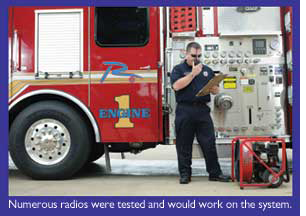A Responsible Steward
By Steve Graves
Spanning 28 square miles just north of downtown Dallas, the city of Richardson is a vibrant community that’s home to 103,201 residents, more that 5,000 businesses and the University of Texas at Dallas. The city of Richardson may best be known, however, as the home of the telecom corridor and 500 of the country’s key high-tech/telecom companies, including AT&T, Verizon, Cisco Systems, Samsung and Fujitsu, all providing leading-edge technology to meet the world’s communications needs.
The Need
In 2010, the city of Richardson found itself in need of a technology upgrade for its existing public safety radio communications network. The aging, trunked radio network that the city depended on for mission-critical communications had become more difficult to maintain and was not providing the level of coverage the community required. In other words, the old network needed to be replaced with a new network that could grow with the city, addressing both its current and future communication needs.
 The Approach
The Approach
The city of Richardson information technology staff has long taken advantage of open Internet Engineering Task Force (IETF) standards to put together a best-in-class, multi-vendor infrastructure for its voice, data and video communications. The city was quick to realize that the APCO Project 25 (P25) suite of standards enables the same “unbundling” of LMR components, defining the common air, console subsystem, fixed station and other interfaces necessary to reliably integrate components from disparate manufacturers.
“The emergence of the modern P25 digital radio ‘open standards,’ as developed by APCO, finally reached sufficient maturity to enable the use of equipment by multiple manufacturers to provide a complete system beholden to no single vendor,” says Brian Davis, deputy CIO, city of Richardson. “This enabled us to use new strategies in purchasing, which saved substantial amounts in comparison to the old-fashioned turnkey, one-vendor approach to purchasing.”
The city of Richardson applied the same principles it used to deploy a leading-edge IT network to the procurement of its new digital LMR infrastructure and radios—splitting the bid strategy into five different parts: system, dispatch console, fire alerting, subscriber units and construction.
System: To ensure that it could consider a wide variety of component vendors, the city required 100% adherence to published industry standards for the P25 core network. The city also let all potential system vendors know that proprietary features (which it believes are of dubious or no practical value anyway) would not be considered.
Dispatch console: There were several console manufacturers that offered open standard solutions that would interoperate with the radio solution the city of Richardson had selected. The city formed a committee of dispatchers to test and review the ergonomics and user interfaces of the various alternatives and make a final recommendation.
Fire alerting: With a number of options available, the city of Richardson evaluated each of the fire alerting solutions available in today’s market and selected the one that best fit its needs.
Subscriber units: The subscriber units currently on the market vary widely in features, quality and price. The city of Richardson formed a subscriber unit selection committee, comprising representatives from the fire and police departments, and asked it to test and critique each radio. The committee then ranked each radio according to its findings, without regard to price.
Construction: The city used a separate procurement method for shelters, towers, concrete, site acquisition, cabling, generators, uninterruptable power supplies, grounding systems, etc.
The Solution
As the first step in the new system procurement process, the city of Richardson selected the CORP25 radio infrastructure from Cassidian Communications, an EADS North America company. The city selected the non-proprietary, digital, trunked CORP25 solution because it utilizes the 100% open-standards model Richardson required, and because the system is compact and IP-based, making it well suited for the city’s data-centric communications environment.
“Because the Cassidian Communications system is originally designed around use over IP networks, we were able to easily integrate their gear into our existing data networks and data centers,” says Davis.
The ability of CORP25 to integrate with the city of Richardson’s existing data network not only saved the city a very large expense, it also eliminated the many security, maintenance and operational problems associated with proprietary, vendor-driven networks. The city of Richardson also found the CORP25 simulcast and voting methods to be technically superior to the other vendors, whose gear had evolved from analog roots.
The city’s second step in the procurement process was to thoroughly test radios from a number of different manufacturers. The 100% standards-compliant CORP25 radio network allowed the city to use a competitive procurement strategy for its radios, with first responders testing more than 30 different radios over a period of several weeks to determine their preferred units.
The in-depth subscriber unit testing allowed the city and the users of the new network to become familiar with the pros and cons of each model and to determine which units best met the needs of the different users. In each case, the city of Richardson was able to purchase the radios identified by its users as “best,” the Motorola APX 7000 series radios for public safety officers and Motorola APX 6000 series radios for all other users.
“By thoroughly testing more than 30 radios from many different vendors, we satisfied ourselves that every single one worked very well on our system choice, and we were able to really take a deep dive into the process of selecting these critical pieces of gear,” says Davis. “We have yet to test a subscriber unit from any manufacturer that showed any problems whatever, when connected to the CORP25 system.”
The city’s final step in the new procurement process was to issue requests for proposal for the construction activities associated with the new LMR network project. Bidding the construction work as separate items, the city of Richardson was able to upgrade much of the equipment and shelters to higher quality units while still realizing significant cost savings.
The Savings
The new procurement process the city of Richardson followed for its P25 LMR system allowed the city to become a smart shopper by accomplishing considerably more with nearly 50% less money than originally projected and to exercise responsible government by returning nearly $1 million of the original $8 million bond issued.
Unbundling its P25 LMR procurement process into five separate components, the city was able to apply savings from one or more areas to increase the quality and quantity of equipment and services in other areas. For example, the city of Richardson spent approximately $1.5 million more on best-in-class radios than it originally anticipated, but this extra cost was more than covered by savings in other areas, such as system construction.
Another key cost savings resulted from the CORP25 infrastructure’s adherence to IETF standards, making it possible for the city of Richardson to avoid building a data network exclusively for the radio system. Because the city was able to use its existing data network and wasn’t forced to buy marked-up switches, routers, dedicated telco circuits or other high-cost items, Richardson was able to save approximately $500,000 on the overall cost of the network.
Further savings came from the city’s ability to select CSSI-compatible dispatch radio consoles, in this case Avtec’s Scout console system, which it viewed as superior and more flexible than those provided in turnkey systems.
Across all elements of its P25 network procurement, the city estimates that it has realized a total savings of more than $4.5 million. By taking full advantage of the new P25 procurement paradigm, the city of Richardson had the freedom to select from the widest possible range of choices, get the right equipment at the right price for its users and continue its responsible stewardship of taxpayer’s money.
Steve Graves is chief information officer for the city of Richardson, Texas, responsible for overseeing all of the city’s technology activities and initiatives.



